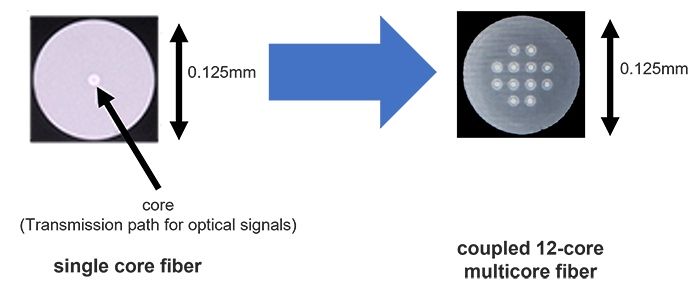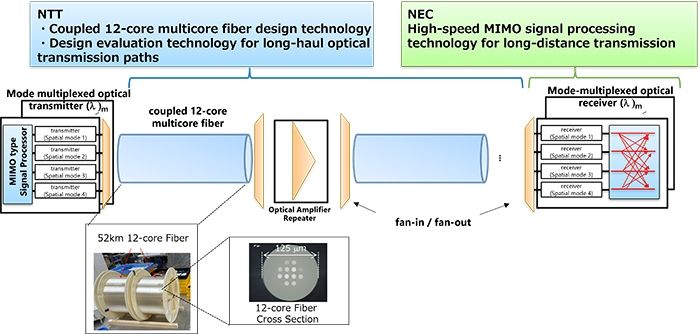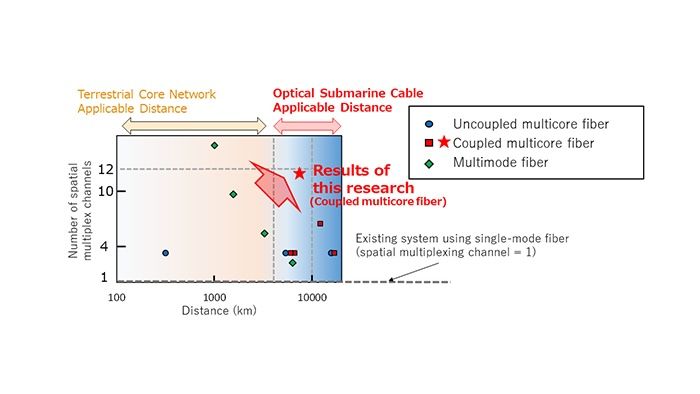NEC Corporation (TSE: 6701) and NTT Corporation (NTT) today announced that they have successfully conducted a first-of-its-kind transoceanic-class 7,280km transmission experiment using a coupled 12-core multicore fiber(1), which consists of 12 optical signal transmission paths in a standard outer diameter optical fiber (0.125 mm). This achievement is expected to be a next-generation transmission infrastructure technology that will contribute to the realization of large-capacity optical networks, including future optical submarine cables.
NEC and NTT successfully conduct first-of-its-kind long-distance transmission experiment over 7,000km using 12-core optical fiber

Background
With the spread of 5G globally and increased communications between data centers, international Internet traffic increased at an average annual rate of 30% from 2018 to 2022 (*2), and this trend is expected to continue. In order to meet the strong communication demand, there is a growing need to increase transmission capacity per optical submarine cable system in addition to increasing the number of optical submarine cables.Existing optical submarine cables use single-core fiber, which has a single optical transmission path called a core within a single fiber. In contrast, research and development is being conducted around the world to increase cable capacity by using multicore fiber, which has multiple cores to increase transmission capacity without changing the standard outer diameter of the fiber. NEC is currently engaged in a project to install a long-haul optical submarine cable system using two-core multicore fiber with two optical transmission paths.
Research Results
As more cores are added to an optical fiber with a standard outer diameter, crosstalk occurs when optical signals leaking from a core interfere with optical signals in adjacent cores, resulting in interference, which deteriorates the quality of mutual communications. Especially in long-distance transmission, in addition to the seriousness of crosstalk, it becomes difficult to receive transmitted signals accurately due to the non-uniformity of delay and loss between optical signals.NEC and NTT have developed the following technologies to address these issues.

1. Development of an algorithm by NEC for demodulation of received signals using Multiple Input Multiple Output (MIMO) technology
Although MIMO technology is commonly used to separate multiple interfering radio signals, the scale of MIMO signal processing that has been put into practical use in existing optical communications is limited to two-polarization multiplexed signals. In addition, multicore fiber with many cores requires more extensive signal processing because the optical signals are further multiplexed. In addition, the random occurrence of crosstalk in long-distance transmission is an issue that must be addressed. NEC has now developed an algorithm for long-distance transmission and applied it to 24 x 24 MIMO (12 cores x 2 polarizations), enabling accurate separation and demodulation of high-speed received signals.
2. Development of a coupled 12-core multicore fiber optical transmission line by NTT
In long-haul optical communications using multicore fiber, when non-uniform delays and losses occur in the propagation between multiplexed optical signals, the circuit resources required for MIMO signal processing during reception increase, making implementation and realization difficult. In addition, non-uniformity in propagation loss greatly limits the distance that can be transmitted. In this study, NTT has developed design technologies for coupled multicore fiber and optical input/output devices (connecting fan-in/fan-out) that can reduce the effects of non-uniformity among signal delay and loss, as well as optical transmission line design evaluation technologies for long-haul applications.Combining these technologies, NEC and NTT conducted long-distance transmission experiments over 7,280km, assuming a transoceanic-class optical submarine cable, and succeeded for the first time in the world in accurately demodulating 12-spatially multiplexed optical signals offline.

Future Developments
The two companies will further advance the research and development of these technologies with the aim of commercializing them as a long-haul, high-capacity optical submarine cable system and terrestrial core network system that will contribute to the realization of a high-capacity optical transmission infrastructure in the IOWN® (*3) concept and Beyond 5G/6G era in the 2030s.NEC and NTT will present the results as a highly scored paper at the Technical Conference of OFC 2024, the world’s largest event on optical communications (March 24 to March 28, 2024, at the San Diego Convention Center in California, USA).
(1) Coupled multicore fiber: An optical fiber in which signals transmitted in each core are separated and demodulated by post-processing on the premise that optical signals leaking from multiple optical transmission paths (cores) in the fiber interfere with and influence each other.
(2)


